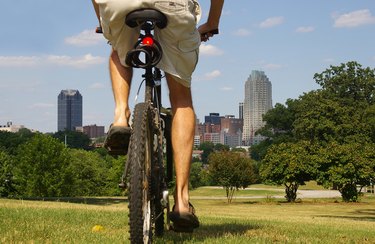
If you've ever noticed the chiseled legs of pro cyclists, you have some idea of the impact biking has on leg musculature. A regular biking routine, whether on roads, mountain trails or inside your local gym, can help you tone and strengthen your calf muscles. Located on the upper back area of your lower leg, calves are necessary for the downward leg thrusts during each time you pedal.
Leg Muscles for Cycling
Video of the Day
The gastrocnemius and soleus muscles of the calves work together with the hamstrings and quadriceps in the upper leg to keep your feet pedaling. The muscles work together to use the thighs like levers, keeping the shorter shins in continuous movement. The difference in length between the thigh and the shin is one factor in the efficiency of the cycling movement.
Video of the Day
Caring for Your Calves
To avoid injury or strain, warm up your calves and other leg muscles before cycling. Spend five to 10 minutes biking at about half your usual intensity, giving your calves a chance to adjust to more intensive exercise. Once you're warmed up, get off the bike and do a few calf stretches. For a basic stretch, position your feet one in front of the other, spaced at least a foot apart. Stand in a spot where you have a wall about arm's length in front of you. Keeping your upper body straight, bend your front leg at the knee and keep your back leg straight. Shift your weight forward, maintaining an upright upper body posture. You should feel the calf of your back leg engage. Use the wall for support as necessary.
Troubleshooting
If, after proper warm-ups and stretching, you still develop strain or discomfort in your calves, it's most likely that you've adopted a biking workout that's too demanding. You can reduce the tendency to cramp by maintaining an adequate salt intake. Drinking sports beverages instead of water can help keep your sodium level up. While on the bike, you can stand on the pedals and let one of your heels drop downward. You should feel your calf stretch gently as you do so. If you aren't noticing the definition in your calves that you're after, you might need to correct your posture. Consult with a personal trainer to check that you've adjusted the bike frame to your body.
Additional Benefits
In addition to building muscle mass, biking rapidly burns calories, making it an effective means of weight loss. According to Medical News Today, cycling at a moderate pace can burn about 300 calories in an hour. In addition, the strength-training aspect of cycling increases your metabolic efficiency, helping your body to burn fat more rapidly. If you have joint problems such as arthritis, cycling is an exceptionally low-impact form of high-intensity aerobic exercise.
- University of Nebraska-Lincoln; Cycling Performance Tips
- Exploratorium: How Do Your Muscles Work?
- University of California Riverside: Stretching Exercises for the Lower Body
- Group Trails; 5 Tips for Toning Legs Through Cycling
- Medical News Today; Bike To Work Week And Reduce Heart Disease Risk By Half